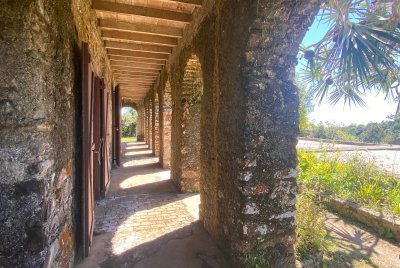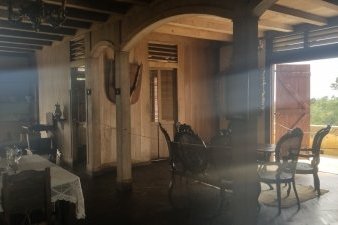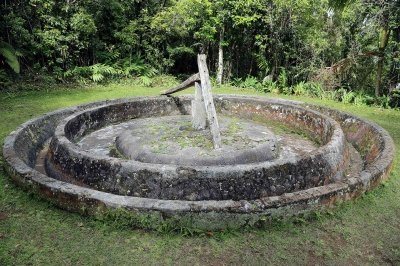Cuba
First Coffee Plantations
The Archaeological Landscape of the First Coffee Plantations in the Southeast of Cuba forms a unique testimony of agricultural exploitation for coffee production.
The remains of 171 historic coffee plantations are located in the mountain valleys of the Sierra Maestra. They were established in the 19th and early 20th century, by French colonial plantation owners who had fled Haiti after independence.
Community Perspective: From Santiago de Cuba, the most accessible seems to be La Isabelica (30km), which has been visited by all reviewers so far. The final 2km to that finca-turned-into-museum are very rough, and you may have to walk.
Site Info
Official Information
- Full Name
- Archaeological Landscape of the First Coffee Plantations in the Southeast of Cuba (ID: 1008)
- Country
- Cuba
- Status
-
Inscribed 2000
Site history
History of First Coffee Plantations
- 2000: Inscribed
- Inscribed
- Type
- Cultural
- Criteria
- iii
- iv
Links
- UNESCO
- whc.unesco.org
All Links
UNESCO.org
- whc.unesco.org — whc.unesco.org/
Community Information
- Community Category
- Cultural Landscape: Relict
Travel Information
Recent Connections
-
No Map
-
Botanical Gardens
At San Juan de Escocia -
Built in the 19th Century
"Coffee production was established in t…
Connections of First Coffee Plantations
- Individual People
-
-
Che Guevara
Sierra Maestra mountains, where he and a small group of revolutionaries survived to re-group
-
- Geography
-
-
Situated in one of the SIDS
Cuba 2000
-
- Trivia
-
-
Largest cultural WHS
81,475 ha -
Built or owned by French
By French plantation owners
-
- World Heritage Process
-
-
No Buffer Zone
Insc 2000 without buffer zone. "Given the strong legislative protection in force in the region, and in particular in the Sierra Maestra Grand National Park, it therefore appeared to ICOMOS that it would be desirable for the entire area to be inscribed on the List, without a buffer zone" (AB eval) -
Perfect Inscriptions
2000 -
No Map
-
- Human Activity
- Constructions
-
-
Aqueduct
Elaborate channels, often built as arcaded aqueducts (as at San Luís de Jacas) (Long Description)
-
- Timeline
-
-
Built in the 19th Century
"Coffee production was established in the island of Saint-Domingue (Hispaniola) by French settlers in the 18th century. The uprisings from 1790 onwards, culminating in the establishment of the independent state of Haiti in 1804, resulted in the flight of French plantation owners, accompanied by many of their African slaves, to the neighbouring island of Cuba, then under Spanish rule. They were granted lands in the south-eastern part of the island in the foothills of the Sierra Maestra, at that time largely not settled and eminently suitable for coffee growing" (AB)
-
- Science and Technology
-
-
Botanical Gardens
At San Juan de Escocia
-
News
No news.
Recent Visitors
Visitors of First Coffee Plantations
- Alejandro Lau
- Alexander Barabanov
- Atila Ege
- Bauchat
- Chantal den Haan
- Claire Bradshaw
- Felicité
- Femke Roos
- Iain Jackson
- Ivan Rucek
- Jonas Kremer
- KarenBMoore
- KateY
- La Concy
- Lara Adler
- Loic Pedras
- Lucio
- Luis Filipe Gaspar
- Lukasz Palczewski
- lynnz317@aol.com
- Maciej Gowin
- Martina Rúčková
- Mikko
- Nihal Ege
- PabloNorte
- palka25
- Paola Laura
- Patrik
- Remski
- Sabrina Liebehentschel
- Slavi
- Stanislaw Warwas
- Tatiana Nikulnikova
- Thomas Buechler
- Thomas van der Walt
- triath
- Vanessa Buechler
- Wojciech Fedoruk
- Xiquinho Silva
- Zizmondka
- Zoë Sheng
Community Reviews
Show full reviews
Visited in January 2023.
Coffee is certainly not a native crop for Cuba, and even the Spaniards who arrived preferred cocoa for a long time, but from the mid-18th century they tried to grow coffee, though not very successfully on the western plains. Everything changed at the end of the same century. On the neighboring island of Hispaniola (Haiti), where coffee production was quite successful, a slave revolution occurred, and those French planters who were not slaughtered by the former slaves escaped, including through the Windward Passage to neighboring Cuba. There, with the Spaniards, everything was still the same. The slaves did not rebel, and it was possible to continue to exploit their sweat and blood. It turned out that the Sierra Maestra mountains with their forests (the beans grew well in the shade of the trees) were much better suited for growing coffee than the plains. The landscape was difficult, it had to be transformed, but soon the slopes were covered with hundreds of new plantations. UNESCO also noted the efforts to transform the relief and the technological innovations that were born in this regard: transport infrastructure, irrigation systems, aqueducts, bridges, and so on. Like sugar ingenios, Cuban cafetals were arranged in roughly the same way. In the center is the planter's house in the Basque style, suitable for the climate, around it are the slaves' dwellings, a mandatory area for drying grain (secadero), outbuildings for cleaning and frying the product, workshops. Well, and fields, sometimes with orchards …
Keep reading 0 comments
Listening to recommendations I picked La Isabela for this. It had at least a road going to the point of the museum on the map. From Santiago it takes around 30 minutes up a steep mountain by car. The first thing you will see is an observatory which requires a hike going up. I doubt anyone goes up here but there was a busload of people having lunch at the cafeteria. This place has nothing to do with the coffee plantations, which I find a great shame because the road continuing on becomes impassable without a 4WD or risk of getting stuck with your crappy Kia. The road to the coffee plantation is another 2km and I drove it for another 1km before giving up on the road, and I'm glad I did. In fact I think I wasn't supposed to drive in here at all and walk all the way from the cafeteria but anyway the last 1km is doable on foot with amazing views of the surrounding lands. There are even some local restaurants which I doubt anyone ever visits. When you reach the marker on the map there is a sign pointing up the the coffee plantation museum including a UNESCO sign.
A few steps higher and you can see the house peeking through the treeline. After arriving you are greeted by a Spanish-speaking museum guide to pay an entrance fee, including paying for taking pictures. There was of course no ticket or whatever but it …
Keep reading 0 comments
Visited La Isabelica in May 2018.
This coffee plantation (cafetal) is the only easily accessible and preserved site of this group. While inscription dossier tells about 171 plantations, we haven’t identified en route any indications or directions for other sites. As we understood they're completely ruined and accessible only with unmarked hiking trails. So, this most famous cafetal La Isabelica (constructed in the second half of 19th century by a Frenchman migrated from Haiti) provides best synthesis of this serial site. There is 2-km walking hike from La Gran Piedra (huge rock formation on top of the mountain) with some stunning views up to the sea. The entrance fee is 2 CUCs and the guy provided overview of the house and surrounding coffee constructions plus described briefly the whole process of coffee cultivation. On the ground floor, there is also exhibition of various torture instruments for the slaves. The French owner (who married slave woman) lived on the first flow and there is carefully reconstructed interior. The most impressive external constructions are secadero (drying surface in front of the cafetal) and grinding mill for the primary processing of the beans (on the foto). Position on the slope of the mountains of Sierra Maestra (La Isabelica is located somewhere 1100 meters over sea level) provided best humid and cool climate for the coffee growth.
Interesting site providing insight on history of probably the most used beverage in the world (or tea is number one?). However, for the future would …
Keep reading 0 commentsThis site lies within a taxi ride of Santiago, Cuba's second city. When I visited, on a pleasant, sunny day in February 2001, the site had only been inscribed for a few months, and perhaps that was the reason I found it almost impossible to get information about it.
UNESCO tells us that the site is in 7 parts. I don't know if any (or all) are contiguous nor how many of these parts I have actually set foot in.
On my visit, because of the condition of the road the taxi driver would go no further than La Gran Piedra, a huge perched rock at an altitude of about 1200m. After that I continued walking uphill for maybe 3kms until I came to La Isabelica. Here the house and plantation of a former coffee grower have been turned into a museum.
The house, once owned by a French planter who, along with a number of his compatriots, moved to Cuba when life in Haiti became difficult, is not lavish but is attractive and has been well restored and furnished. Access to the first floor living areas is only by way of a narrow bridge over the deep trench dug to surround the house.
It was not clear to me where the plantation labourers (were they still slaves at that time?) lived. Perhaps their (presumably less substantial) dwellings have since been reclaimed by the forest.
The ground floor of the building seemed to be occupied solely by utility rooms and …
Keep reading 0 comments